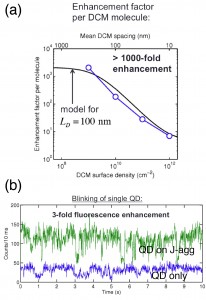Absorption and Fluorescence Enhancement of Single Molecules and Quantum Dots Using an Excitonic Antenna
- Category: Materials, Nanotechnology, Optics & Photonics
- Tags: gleb akselrod, vladimir bulovic
Nature presents us with a fundamental mismatch between the “size” of visible light (~250 nm in free space) and the size of the absorption cross-section of molecules, which is ~ 0.1 nm in diameter at room temperature. Therefore, the probability that a single photon will be absorbed by a single molecule is ~10-7. Since most photonic and optoelectronic devices at some level depend on the absorption and emission of light, it is of great interest to engineer solutions to the limited absorption abilities of single molecules, with applications to single molecule sensing, bioimaging, single photon sources, and down-conversion for lighting. The last decade has seen tremendous interest in the ability of plasmon modes to increase the absorption cross-section molecules, owing to the small wavelength and high field localization of plasmons[1]. We have developed and demonstrated an alternative, exciton-based approach to absorption enhancement using organic thin films of highly absorbing (α = 106 cm-1) J-aggregates. Acting as an excitonic antenna, the J-aggregates absorb incident light, the generated excitons diffuse through the film, and they eventually come within a Förster resonant energy transfer radius of the acceptor molecules situated on top of the film, thus transferring the exciton energy (Figure 1)[2]. In this scheme each acceptor molecule “sees” a large number of J-aggregate donor molecules due to the unusually long exciton diffusion length (~100 nm)[3],[4] in J-aggregates. Using this approach we have demonstrated enhancement factors over 1000 for the absorption and fluorescence of ensembles of DCM laser dye molecules (Figure 2a), which compares well with the best enhancements seen with plasmonic approaches[1]. We have confirmed that the enhancement can be achieved on the single emitter level by performing confocal imaging of single quantum dots coupled to the J-aggregate excitonic antenna (Figure 2b). Next steps include the integration of this approach with active optoelectronic and photonic devices.
- Figure 1: Schematic of absorption and fluorescence enhancement using the J-aggregate excitonic antenna.
- Figure 2: (a) Fluorescence enhancement of DCM molecules at varying concentrations, showing good agreement with predictions for a J-aggregate exciton diffusion length of 100 nm. Increase in enhancement at lower concentration occurs because each molecule sinks to a larger number of J-aggregate excitons. (b) Enhancement of single colloidal core-shell CdSe quantum dot imaged by confocal microscopy.
- A. Kinkhabwala, Z. Yu, S. Fan, Y. Avlasevich, K. Mullen, and W. Moerner, “Large single-molecule fluorescence enhancements produced by a bowtie nanoantenna,” Nature Photonics, vol. 3, pp. 654–657, 2009. [↩] [↩]
- G. M. Akselrod, B. J. Walker, W. A. Tisdale, M. G. Bawendi, and V. Bulovic, “Twenty-Fold Enhancement of Molecular Fluorescence by Coupling to a J-aggregate Critically Coupled Resonator,” ACS Nano, vol. 6, pp 467-471, Nov. 2011. [↩]
- G. M. Akselrod, Y. Tischler, E. Young, D. Nocera, and V. Bulovic, “Exciton-exciton annihilation in organic polariton microcavities,” Physycal Review B, vol. 82,,pp. 1–4, Sep. 2010. [↩]
- J. Moll, W. J. Harrison, D. V Brumbaugh, and A. A. Muenter, “Exciton annihilation in J-aggregates probed by femtosecond fluorescence upconversion,” Journal of Physical Chemistry A, vol. 104,, pp. 8847–8854, Jan. 2000. [↩]

